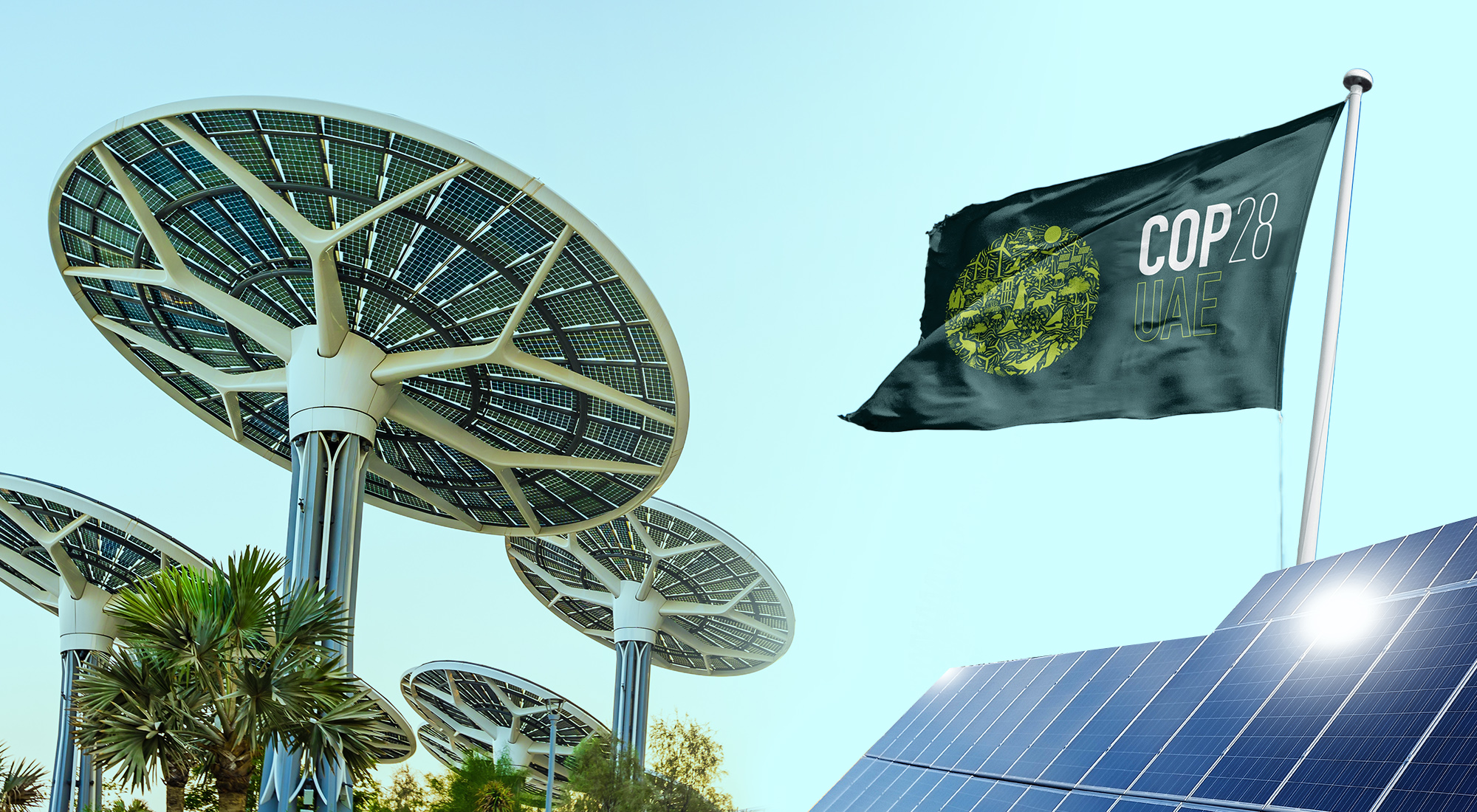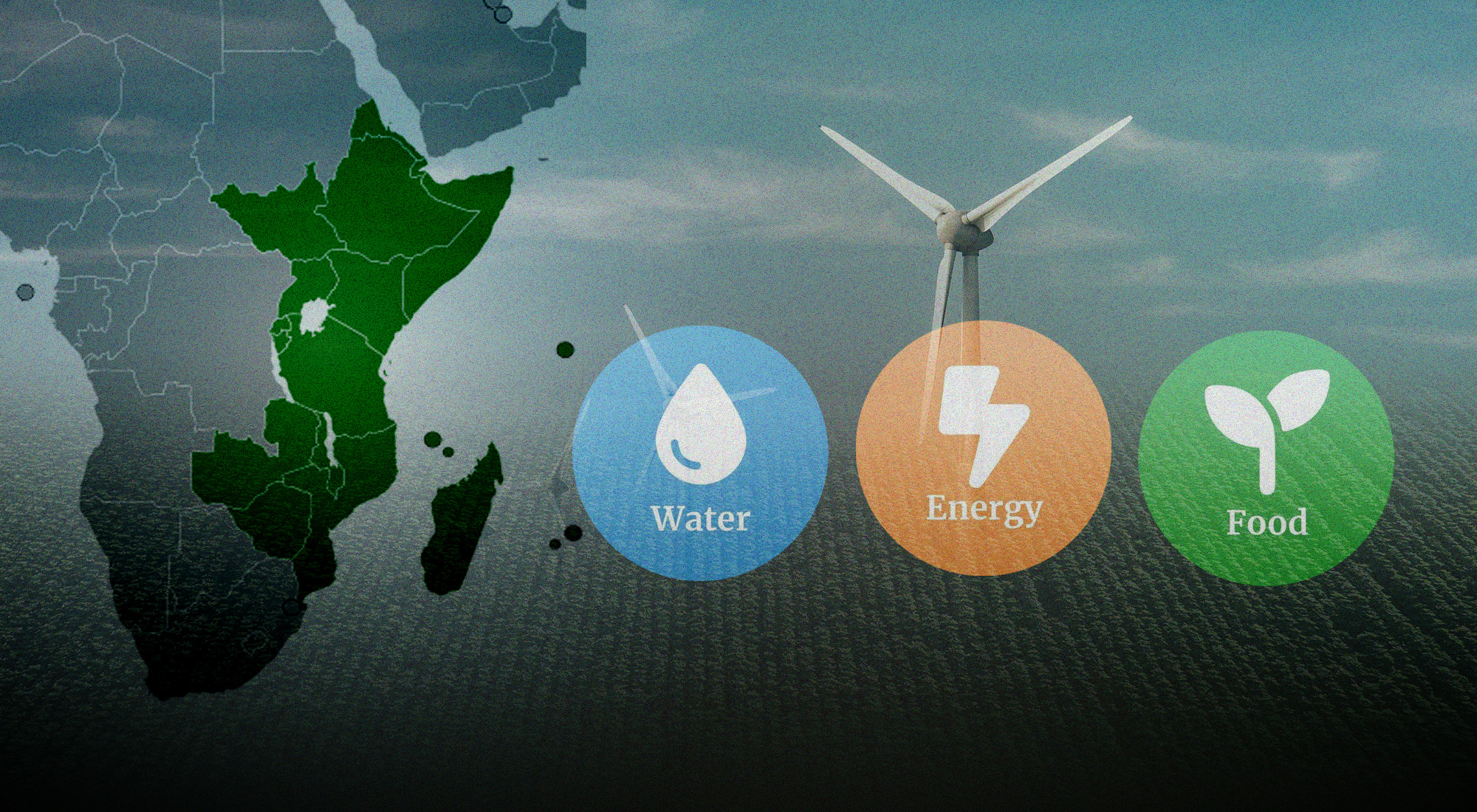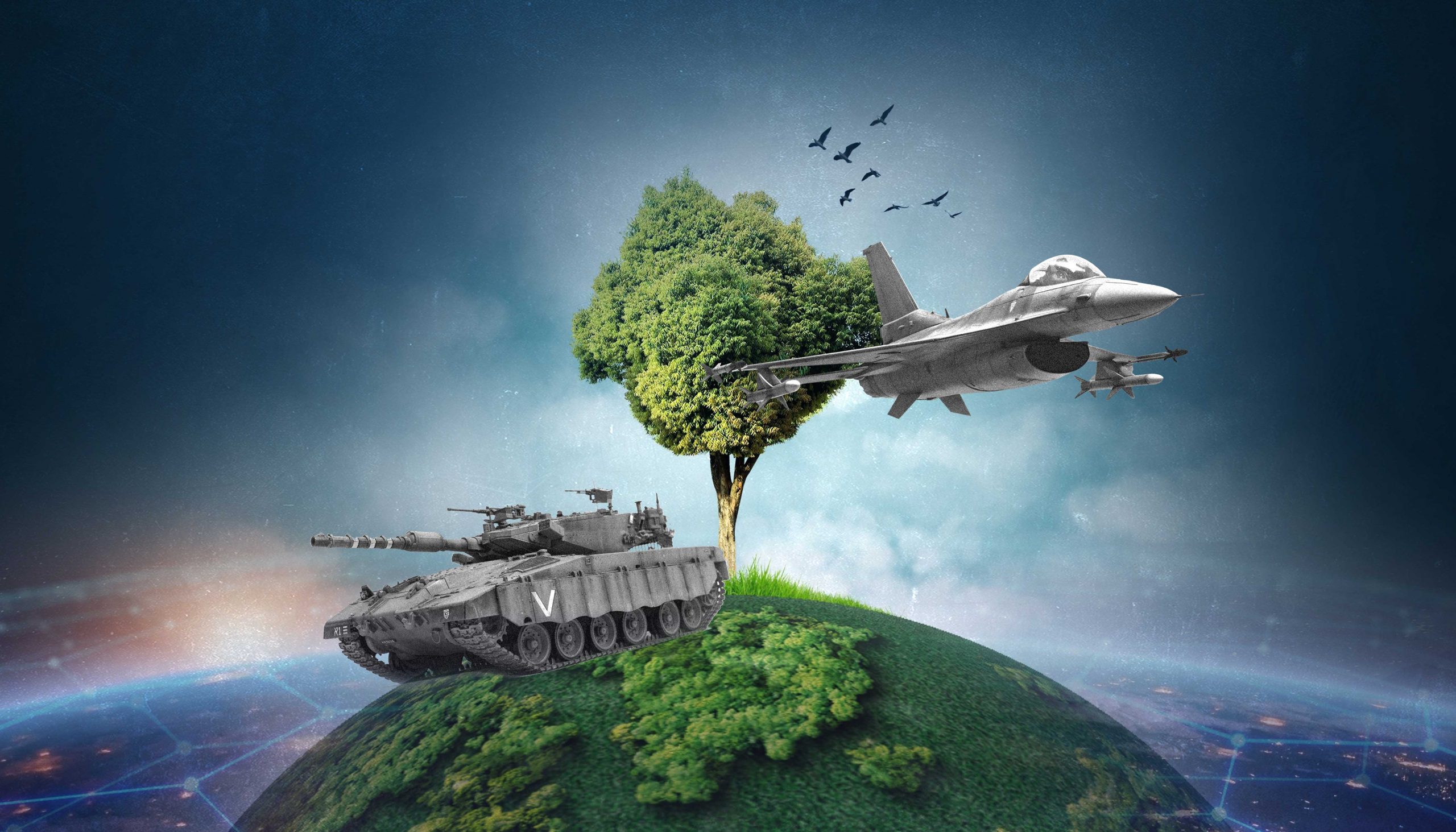1. Introduction
Climate change is largely perceived as a “threat multiplier” as its effects “have the potential to exacerbate pre-existing threats and other drivers of instability to contribute to security risks.”[1] The countries of the Arabian Peninsula that form the Gulf Cooperation Council (GCC) are highly vulnerable to the effects of climate change. As the global center of fossil fuels, the Gulf states have the highest carbon footprint per capita and have a great deal of responsibility to contain the harmful greenhouse gas emissions (GHG)[2] from their oil and gas operations. Accordingly, they have launched ambitious climate programs and policies over the last years. In other words, they have managed to transform “what was previously a liability for their regional and international reputations into something of a strength.”
This policy brief first sheds light on the complex and ‘wicked’ problem of climate change and its various dimensions that threaten stability and prosperity among the GCC states. It then discusses some of the most notable plans and programs aimed at addressing the climate crisis. Finally, the brief ends with several policy recommendations addressed to GCC policymakers on how they can mitigate and potentially overcome certain obstacles in order to work towards collective, substantial, and robust climate action.
The analysis finds that there are three shortcomings that might hamper the provision of adequate and comprehensive solutions. These include a strong focus on energy associated with a potential risk of ‘carbon lock-in’, a state-centered and exclusive governance model, and a limited or cautionary willingness to engage in full-fledged multilateral action with other peer countries.
2. Climate Change and Its Multiple Threats and Challenges
Gulf states are increasingly feeling the direct impact of anthropogenic climate change. In essence, there are two imminent climate risks, namely slow and rapid onset of natural hazards. One of the greatest long-term climate effects on the Arabian Peninsula is certainly the constant rise in temperature. This “desertification in the desert”[3] will negatively affect agricultural productivity and exacerbate the existing problem of water scarcity. All GCC states are currently under the water poverty threshold of 500 m3 per capita of water available annually.[4] There are climate-based models which forecast that the so-called land surface temperature might go beyond 6°C by the end of this century if emissions are not drastically cut by then.[5]
At the same time, the region also faces stronger humidity, which is caused by more widespread irrigation and the surrounding water bodies.[6] During summer, temporal ultra-extreme heatwaves are occurring more often, especially in densely populated urban areas. This heat stress witnessed in the Arabian Peninsula poses significant health risks. Already in 2015, it was projected that in the mid to long term, people are likely “to experience temperature levels that are intolerable to humans.”[7] More recent studies confirm this development, which might ultimately leave parts of the GCC uninhabitable by the end of this century.[8] According to a modelling study published in The Lancet Planetary Health, “over 80% of predicted heat-related deaths in the Middle East and North Africa (MENA) by the end of the century could be prevented if global warming is limited to 2°C.”[9]
Ocean warming is equally worrisome. The semi-closed, relatively shallow Arabian sea is the hottest maritime water body on earth, reaching hourly temperatures of more than 37°C during summer months. It is projected that the reef-bottom temperature is warming up 2 to 3 times faster than the average global rate.[10] Besides extreme evaporation, this will have dramatic effects on the biodiversity in the sea and coastal areas. Despite the fact that most species are more tolerant to heat than in other regions, it is expected that a further rise in temperature will cause mass coral bleaching and mortality, and significantly reduce the habitats of vulnerable or endangered species such as the hawksbill turtle, green turtle and the dugong.[11] Simultaneously, elevated water temperatures accelerate biofouling coverage (i.e., the unintentional accumulation of microorganisms, plants, algae, and animals).
In addition to warming, sea level rise is another slow-onset, major risk.[12] It endangers large parts of the low-lying coastal areas in Bahrain, Qatar, and the United Arab Emirates (UAE). It thus threatens, in particular, the densely populated urban centers, in which more than two-thirds of all GCC populations reside.[13] The frequency and amplitude of climate variability shifts also with climate change. Besides occasional heat waves, the Gulf states are threatened by increasing extreme weather events such as dust storms, cyclones, and flash floods, which happen more often and severely as a consequence of climate change. Over the last several years, countries like Saudi Arabia, Oman and Yemen have been hit by deadly flash floods.[14] In autumn 2021, for example, Oman was hit by Cyclone Shaheen, which brought flash floods and landslides, killing four people, and displacing several hundreds. The region, known as “one of the most important dust-source areas in the world,” has experienced more frequent and greater dust storms lately.[15] During the summer of 2022, the Gulf region was hit by intensified and tenacious sand and dust storms, which are usually caused by strong winds, lack of vegetation and absence of rainfall.[16]
The various long-term and occasional effects of climate change are closely intertwined with human-caused environmental destruction, resource extraction, and socioeconomic development in the region. Activities from the fossil industry have led to widespread pollution on land, air, and sea. Water scarcity and the constant growing demand for freshwater has resulted in a massive expansion of desalination plants. This technology is not only costly and energy intensive, but it is also ecologically harmful as brine and other chemical by-products from the process are often released into the sea.[17] Hence, one direct example of an increasing urban and industrial development includes eutrophication and sewage discharge in the Arabian Sea,[18] making it not only the warmest but also the globe’s most toxic sea.
Human activities including oil and gas exploration, brine waste, domestic sewage, and runoff, as well as coastal transformation (e.g., dredging activities for the creation of artificial islands) exacerbate the situation. The consequences of the high level of sewage and desalination brine water effluents are further worsening as there is less outflow with freshwater sources, for instance due to water diversions and dam constructions along the Tigris-Euphrates River basins,[19] as well as less exchange with the Indian Ocean as a result of climate change and warming anomalies.[20] Simultaneously, the rapid expansion of harmful algal bloom in the Arabian Sea sometimes blocks the operation of desalination plants. Higher levels of salinity in the Gulf will only result in stronger reliance on groundwater reserves and expansion of desalination plants that are further accelerating the resource scarcity. In a nutshell, it is a vicious cycle of unsustainability.
Increasing water scarcity due to temperature rise, pollution, and overconsumption negatively affects agriculture and food production, which undermines food security.[21] The numerous sources of pollution in the Arabian Sea are anticipated to have a severe impact on declining fish stock. It is assumed that Qatar, Oman, and the UAE may experience “a drop of more than 30% in future catch potential.”[22] Rapid onset of climate hazards have also caused economic damage. Flash floods are significantly destroying infrastructure while transboundary sand and dust storms are disrupting vital trading routes and transportation systems (e.g., ban on flights).[23] Additionally, climate change hampers sustainable transformation as renewable solar panels malfunction when covered by dust or when temperatures rise above 25°C.[24]
3. Analysis
Whereas the Gulf states are in many ways particularly vulnerable to the impacts of climate change, they have also embarked on a journey to address and solve these problems. For more than a decade, Gulf states have received attention by developing cutting-edge sustainable projects or greening already existing grand projects. Examples include Abu Dhabi’s grand ‘Masdar Initiative’ and the region’s first-of-its-kind eco-city; Qatar’s announcement that it would hold the first carbon-neutral FIFA World Cup; and Saudi Arabia’s latest Saudi Green Initiative and Middle East Green Initiative. Considering their economic diversification efforts to reduce dependence on oil and gas, five GCC states – Bahrain, Kuwait, Oman, Saudi Arabia, and the UAE – have committed to achieving net-zero targets between 2050 and 2060.
To achieve these ambitious goals, these countries have developed mid-to longer-term programs and initiatives and have created the institutional architecture conducive to monitor and control the progress. However, there are often gaps in the information about the overall process, including assessments of the financial, technical, and economic feasibility.[25] This is of some concern insofar as there has been a gap between green pledges and implementation among decision-makers in the past.[26] As Aisha al-Sarihi notes, “the gap between the current scale of these developments and where the countries want to be in a net-zero future is relatively substantial.”[27]
Much of the GCC states’ focus centers on mitigation and low-carbon energy development. Accordingly, the deployment of renewable energy sources increases rapidly. Large utility-scale renewable energy projects have been inaugurated in Saudi Arabia, including solar photovoltaic (PV) plants in Sudair, Jeddah, and Rabigh. In addition, a large wind park has been developed at Dumat Al-Jandal. More recently, three wind energy and two solar energy projects, with a total capacity of 3300 megawatts of energy, have been launched by the Saudi Power Procurement Company.[28] With a total share of around 7% (around 2570 megawatts), the UAE has by far the highest renewable energy capacity among the Gulf states and pushes further. It has the most cost-effective solar energy production system in the world and hosts three of the world’s biggest and most cost-efficient solar power facilities. These include two giga-scale projects, namely Dubai’s Mohammed bin Rashid Al Maktoum Solar Park (5000 megawatts) and Abu Dhabi’s Al Dhafra Solar Project (2000 megawatts).[29] Furthermore, the inauguration of the region’s first commercial nuclear power plant, Barakah, has been another mainstay. Once finished and fully operational, it will have a capacity of around 5380 megawatts.
Shortly before hosting the FIFA World Cup, Qatar also unveiled its first large solar power plant at Al Kharsaah, with a capacity of 800 megawatts. Yet, while these developments appear promising, they might not be enough. On the one hand, one has to remember that there might be a mismatch between the amount of installed renewable energy sources and their production (i.e. malfunction due to sand/dust particles and high temperatures). On the other hand, when considering the latest plans of large green hydrogen production for domestic use and export, the current renewable energy capacity will by far be insufficient.[30]
Carbon removal is another key topic among Gulf decision-makers. This technology is seen as a key element towards net-zero as large amounts of CO2 – particularly from the hard-to-abate sectors such as the aviation, shipping, or steel industries – need to be removed from the atmosphere.[31] For some time, several Gulf states have been experimenting with carbon capture, use and storage (CCUS) technology. In this regard, the captured CO2 is either permanently stored deep underground or reused by turning it into solid minerals, alcohol products like methanol, or commercial products including plastics. Another favored practice of CCUS, and currently also the only commercially viable form, is ‘enhanced oil recovery’, where the captured carbon is reinjected into oil reservoirs to increase the overall pressure and drill more oil.[32] So far, the three CCUS pilot projects in the Middle East are all in the Gulf, namely in Saudi Arabia, Qatar, and the UAE. In total, they account “for about 10 per cent of the 40 million tons of carbon dioxide captured globally.”[33] The Gulf states have several conditions well-suited for CCUS including favorable geology with immense storage capacity, remote areas, as well as their long experience with carbon-based operations. A stronger focus on carbon sequestration will ultimately also ease widespread concerns about stranded assets (e.g., hydrocarbon resource reserves, existing industries, or infrastructure) and ensure the Gulf’s relevance as the global “center of the hydrocarbon industry.”[34] Recent announcements of developing blue hydrogen (produced from gasification with CCUS) further underlines the future role and potential for carbon sequestration.[35]
Nature-based solutions of carbon offsetting are also debated and integrated in the Gulf’s net-zero plans. This includes conservation and/or restoration of mangrove ecosystems along the Arabian sea as well as large-scale afforestation programs on land. Saudi Arabia, in particular, is currently championing this development through its Saudi and Middle East Green Initiative, which foresees the planting of 10 billion trees within the Kingdom and 40 billion trees across the Middle East.[36] In the UAE, a consortium of private, public, as well as civil stakeholders, has also launched the “Nature-based Solutions (NbS) for Climate, Biodiversity & People” project, which foresees an improved and more systematic management of mangroves, seagrasses and saltmarshes.[37]
The various investments and initiatives towards more climate action and a low-carbon transition are certainly laudable. However, three shortcomings stand out and need to be mentioned when looking at the current plans in the GCC. First, there is a strong, maybe too strong, focus on energy diversification and resilience that runs the risk of overlooking associated climatic consequences and/or causing unwarranted negative side-effects. As previously mentioned, and frequently emphasized by concepts such as the water-energy-food[38] or energy-environment-climate nexus,[39] combating climate change, environmental conservation, and sustainable resource management are complex issues and closely entangled. For instance, the transformation of energy systems brings new challenges to the extraction of other resources, above all, water. As stressed above, in order to be operational, many solar PV panels need to be cleaned regularly with freshwater. Also, the ambitions for producing green hydrogen seem like “a distant and unlikely prospect” when considering the unavailability of water;[40] around nine liters of freshwater are needed to produce one kilogram of hydrogen.[41] Furthermore, the Gulf’s pursuit for nuclear energy as a matter of energy security comes at the expense of surrounding ecosystems, as questions of nuclear waste disposal are still not resolved. In addition to diversification efforts towards low-carbon energy systems, all Gulf states continue to invest in fossil fuel production, including more the climate-friendly natural gas, with the help of new technologies and innovation. In this regard, CCUS with enhanced oil recovery may reduce emissions and should be considered as a climate-friendly method of mitigation.[42] Nonetheless, with a steady demand on energy and growing consumption, it is doubtful whether GHG emissions will drastically sink as required by international climate agreements. Overall, an almost exclusive focus on carbon units alone is effectively unsustainable.
The second aspect, which is partially related to the first one, comprises the climate governance model in the Gulf states. So far, climate policy has happened in a centralized, top-down approach. Most programs, initiatives and projects are state-led or sponsored with very little bottom-up participatory engagement.[43] Moreover, it is grounded in a techno-optimistic view that is also historically deeply entrenched in Western discourses about ‘ecological modernization’. It assigns a strong role to science, technology, and the state to provide solutions to the climate crisis, without compromising the high welfare standards and economic development or comprehensively targeting aspects of environmental consciousness and energy conservation.[44]
However, the emergence of new ‘technological fixes’ such as CCUS have their very own ecological problems and cannot be seen as viable, scalable solutions so far.[45] Furthermore, it is not clear how grand projects such as the Saudi and Middle Eastern Green Initiative with the planting of billions of trees will be implemented and whether it will actually work. For instance, past experiences in the Gulf have shown that large-scale “greening the desert” projects have low chances of success.[46] Additionally, scientific studies show that “irrigation can increase the heat stress by 2°C and 3°C with respect to its surrounding.”[47] Consequently, a more comprehensive and transparent reporting of the current climate action plans with regards to the feasibility, status, and future pathways of the Gulf’s net-zero developments, would increase the chances of successful deep decarbonization.
Thirdly, there is very little regional coordination and cooperation. For some, climate governance should be conceived of as “virtually a synonym for international environmental cooperation; for the network of international environmental organizations and conventions and the spaces between them.”[48] And yet, whereas the Gulf states have been more active on the international level of global climate politics, there are very limited multilateral approaches on regional climate governance among the countries. Regional institutional frameworks and networks barely exist and observable exchanges between countries happen rather seldomly, and if they do, it is rather in a bilateral way.[49] So far, Gulf states are following their very own climate policies. This approach leaves a certain risk of exclusion and creates competition instead of much-needed cooperation.
4. Conclusions and Recommendations
Climate change is the ‘grand challenge’ of the 21st century. While there are already imminent threats stemming from global warming, it is expected that the slow and rapid-onset effects will only increase in the future. The oil and gas rich Gulf states, which had hampered serious climate efforts for some time, have radically changed their approach over the last decades. Today, with all their capacities, the Gulf states play a more constructive role in fighting climate change. However, there is still a long and bumpy road ahead if they want to become leading forces in this development.
The following recommendations are based on the short analysis and reflection of the current climate action plans in the GCC presented in the previous section. They do not account for completeness but rather provide inspirations for further courses of action. Furthermore, it should be noted that the GCC is by no means a monolithic bloc and the diverse characteristics need to be recognized to articulate and develop strategies towards climate change. In this regard, these recommendations address all GCC states, but do consider that there are some countries that are either better equipped to lead this development (e.g., Saudi Arabia, Qatar, or the UAE) or have already a past record on pushing forward regional environmental initiatives (e.g., Kuwait or Oman).
· Gulf leaders and environmental policymakers in the GCC should advance and improve data collection by conducting scientific studies that comprehensively analyze climate change effects and its various impacts on related dimensions such as environmental protection and sustainable resource management. This does not only include baseline data but also strongly considers humanity as a further stressor. While the amount of science-based literature on climate change is steadily increasing, there is a lack of social science knowledge, which must be better addressed. In other words, we need a better understanding of the many multiple dimensions and interactions of human-nature relations in the Arabian Peninsula. Investments in better monitoring tools that are applied widespread as well as more coordination among research institutes and universities is a starting point. The usage of remote sensing (e.g., satellite technology or drones) as well as deploying Geographic Information System (GIS) technology to map and observe environmental change, as already practiced in some states like Saudi Arabia, is welcome and promising.
· To avoid a mismatch between pledges and implementation, more transparent environmental reporting is needed. This is particularly crucial when considering that environmental information sharing and consultancy are key steering elements of successful climate policymaking. Channels of communication and forums should be created that include and mobilize various stakeholders from civil society to academia and think tanks, as well as businesses. There is also a further need to develop more information campaigns and education and awareness programs that target local populations and various segments of society such as women, youth, and migrants. The fact that several universities (especially in Qatar and the UAE) have started to develop study programs on sustainable development is a promising step. Equally, local engagement by civil actors on awareness campaigns such as beach cleaning is laudable. More widespread and systematic efforts, however, especially by governmental agencies, would foster this development. Another element of inclusion could entail a gradual transformation from the current centralized and utility-based energy production towards a decentralized approach that includes further incentives. This could include policy instruments like providing long-term contracts, guaranteed grid access, and price certainty to small and medium renewable energy companies (e.g., feed-in tariffs) or offering concessionary loans or tax credits for private solar PV cells. Overall, the communication, attitude, and engagement cycle could be a possible entry point for such a profound energy transformation. It foresees several intertwined steps of (a) creating channels of communication and awareness with a special focus on the needs of various social groups and unveiling details of climate projects; (b) providing opportunities for engagement and participation in the energy transition; and (c) increasing the attitude towards cleaner energy through easy and cheap access.
· Finally, there is a
dire need to foster environmental cooperation within the Gulf states. This
could include the empowerment of already existing organizational structures
such as the GCC’s Committee for Climate Change, the Middle East Desalination
Research Center (MEDRC), or the Regional Organization for the Protection of the
Marine Environment (ROPME). However, it can also mean creating new frameworks
from scratch and incorporating existing structures, agents, and mechanisms.
Conceivable would be the establishment of a climatic hub to coordinate and
exchange climate-friendly research and development, innovation, or technology,
as well as a climate-water-energy-food network that tackles questions of
sustainable resource management. Finally, awareness campaigns, workshops and
trainings for policymakers that highlight the GCC’s environmental
interdependence and urgent need to work in a collaborative manner would be
conducive to finding regional solutions against the looming climate peril in
the Gulf.
4. Bibliography
Al-Akwa, Khalid, and Tobias Zumbrägel, “The Disaster of Yemen’s Flash Floods. Impact of and Local Responses to the Torrential Rains and Flooding in 2020,” Brief 21, CARPO, December 7, 2021, http://bitly.ws/GcBm.
Al-Said, Turki, S. W. A. Naqvi, Faiza Al-Yamani, et. al., “High Total Organic Carbon in Surface Waters of the Northern Arabian Gulf: Implications for the Oxygen Minimum Zone of the Arabian Sea,” Marine Pollution Bulletin 129, no. 1 (2018): pp. 35–42, https://doi.org/10.1016/j.marpolbul.2018.02.013.
Al-Saidi, Mohammad, “Energy Transition in Saudi Arabia: Giant Leap or Necessary Adjustment for a Large Carbon Economy?” Energy Reports 8, no. 3 (2022): pp. 312–18, https://doi.org/10.1016/j.egyr.2022.01.015.
Al-Sarihi, Aisha, and Mari Luomi, Climate Change Governance and Cooperation in the Arab Region, EDA Insight, Emirates Diplomatic Academy, July 2019, http://bitly.ws/vcrx.
Al-Sarihi, Aisha, and Noura Mansouri, “Renewable Energy Development in the Gulf Cooperation Council Countries: Status, Barriers, and Policy Options,” Energies 15, no. 5 (2022): p. 1923, https://doi.org/10.3390/en15051923.
Al-Sarihi, Aisha, “The GCC and the Road to Net Zero,” Middle East Institute, March 2, 2023, http://bitly.ws/GcHJ.
Ansari, Dawud, “The Hydrogen Ambitions of the Gulf States: Achieving Economic Diversification While Maintaining Power,” SWP Comment No. 44, Stiftung Wissenschaft und Politik, July 2022, https://doi.org/10.18449/2022C44.
Ben-Hasan, A., and V. Christensen, “Vulnerability of the Marine Ecosystem to Climate Change Impacts in the Arabian Gulf—An Urgent Need for More Research,” Global Ecology and Conservation 17 (2019), https://doi.org/10.1016/j.gecco.2019.e00556.
Beswick, Rebecca R., Alexandra M. Oliveira, and Yushan Yan, “Does the Green Hydrogen Economy Have a Water Problem?” ACS Energy Letters 6, no. 9 (2021): pp. 3167–69, https://doi.org/10.1021/acsenergylett.1c01375.
Blowers, Andrew, “Environmental Policy: Ecological Modernisation or the Risk Society?” Urban Studies 34, no. 5–6 (1997): pp. 845–71, https://doi.org/10.1080/0042098975853.
Farag, Mona, “Flash Floods Sweep Makkah as Jeddah Braced for Downpours,” The National, December 23, 2022, http://bitly.ws/GcD2.
Filho, Walter Leal, and Dinesh Surroop, eds., The Nexus: Energy, Environment and Climate Change, 1st ed. (Cham: Springer International Publishing, 2018), https://doi.org/10.1007/978-3-319-63612-2.
Gibbs, David, “Ecological Modernisation, Regional Economic Development and Regional Development Agencies,” Geoforum 31, no. 1 (2000): pp. 9–19, https://doi.org/10.1016/S0016-7185(99)00040-8.
Goodman, Sherri, and Pauline Baudu, Climate Change as a ‘Threat Multiplier;: History, Uses and Future of the Concept, Briefer No. 8, Center for Climate & Security – Council on Strategic Risks, January 3, 2023), http://bitly.ws/G4Tr.
Ho, David T., “Carbon Dioxide Removal Is Not a Current Climate Solution — We Need to Change the Narrative,” Nature 616, no. 9 (2023), https://doi.org/10.1038/d41586-023-00953-x.
IPCC, “Climate Change 2022: Impacts, Adaptation and Vulnerability,” Contribution of Working Group II to the Sixth Assessment Report of the Intergovernmental pv on Climate Change (Cambridge University Press, 2022): p. 1478, http://bitly.ws/vRKQ.
Kamel, Deena, “Saudi Arabia Launches Five Renewable Energy Projects,” The National, September 25, 2022, http://bitly.ws/GcIP.
Keulertz, Martin, and Tony Allan, “The Water-Energy-Food Nexus in the MENA Region,” in Routledge Handbook on Middle East Security, ed. Anders Jägerskog, Michael Schulz, and Ashok Swain (Routledge, 2019): pp. 157–68.
Kiyasseh, Lama, “Strong Momentum in Saudi Arabia’s Drive toward Renewables and Infrastructure,” Middle East Institute, January 4, 2022, http://bitly.ws/GcJf.
Koch, Natalie, “Gulf Hydrogen Horizons: Why Are Gulf Oil and Gas Producers so Keen on Hydrogen?” Institute for Advanced Sustainability Studies (IASS), November 2022, http://bitly.ws/GcK4.
Kumetat, Dennis, “Climate Change on the Arabian Peninsula: Regional Security, Sustainability Strategies, and Research Needs,” in Climate Change, Human Security and Violent Conflict, ed. Jürgen Scheffran et. al. (Springer VS, 2012): p. 374.
Lachkar, Z., M. Lévy, and K. S. Smith, “Strong Intensification of the Arabian Sea Oxygen Minimum Zone in Response to Arabian Gulf Warming,” Geophysical Research Letters 46 (2019), https://doi.org/10.1029/2018GL081631.
Mills, Robin, “Scaling Up Carbon Capture in the Mena Region,” The National, January 23, 2023, http://bitly.ws/GcKD.
Ouis, Pernilla, “‘Greening the Emirates’: The Modern Construction of Nature in the United Arab Emirates,” Cultural Geographies 9, no. 3 (2002): pp. 334–47, https://doi.org/10.1191/1474474002eu252oa.
Pal, Jeremy S., and Elfatih A. B. Eltahir, “Future Temperature in Southwest Asia Projected to Exceed a Threshold for Human Adaptability,” Nature Climate Change 6 (2015), https://doi.org/10.1038/nclimate2833.
Pouran, Hamid, and Hassan Hakimian, eds., Environmental Challenges in the MENA Region: The Long Road from Conflict to Cooperation (Gingko Library, 2019).
Pouran, Hamid, “The Middle East’s Worsening Dust Storms Are Making It Harder to Deploy Solar Energy,” Middle East Institute, July 21, 2022, http://bitly.ws/GcHh.
Rahman, Muhammad Tauhidur, Adel S. Aldosary, Kh Md Nahiduzzaman et. al., “Vulnerability of Flash Flooding in Riyadh, Saudi Arabia,” Natural Hazards 84 (2016), https://doi.org/10.1007/s11069-016-2521-8.
Raouf, Mohamed, “Climate Change Threats, Opportunities, and the GCC Countries,” Middle East Institute, April 1, 2008, http://bitly.ws/GczM.
Rizzo, Agatino, “Sustainable Urban Development and Green Megaprojects in the Arab States of the Gulf Region: Limitations, Covert Aims, and Unintended Outcomes in Doha, Qatar,” International Planning Studies 22, no. 2 (2017): pp. 85–98, https://doi.org/10.1080/13563475.2016.1182896.
Safieddine, S., C. Clerbaux, L. Clarisse et. al., “Present and Future Land Surface and Wet Bulb Temperatures in the Arabian Peninsula,” Environmental Research Letters 17, no. 4 (2022), https://doi.org/10.1088/1748-9326/ac507c.
Science Daily, “Limiting Warming to 2°C May Avoid 80% of Heat-related Deaths in Middle East and North Africa,” April 4, 2023, http://bitly.ws/G4XK.
Siddiqui, Sabena, “A Transboundary Threat: The Prevalence of Sandstorms in the GCC Pose a Severe Climate Risk,” The New Arab, July 18, 2022, http://bitly.ws/GcE9.
The NbS Project in the UAE, “Nature-based Solutions for Climate, Biodiversity & People” http://bitly.ws/GcTz (accessed April 21, 2023).
Vogler, John, “The European Contribution to Global Environmental Governance,” International Affairs 81, no. 4 (2005): p. 835, https://doi.org/10.1111/j.1468-2346.2005.00487.x.
Wabnitz, Colette C. C., Vicky W. Y. Lam, Gabriel Reygondeau et. al., “Climate Change Impacts on Marine Biodiversity, Fisheries and Society in the Arabian Gulf,” PLoS ONE 13, no. 5 (2018), https://doi.org/10.1371/journal.pone.0194537.
Zumbrägel, Tobias, “Hydrogen Partnerships between Germany and the Gulf: Too Fast and Too Soon?” Trends Research & Advisory, October 27, 2022, http://bitly.ws/GcF9.
[1] Sherri
Goodman and Pauline Baudu, Climate Change as a ‘Threat Multiplier;: History,
Uses and Future of the Concept, Briefer No. 8, Center for Climate &
Security – Council on Strategic Risks, January 3, 2023), http://bitly.ws/G4Tr.
[2]
Sometimes also labelled as Carbon Dioxide Equivalent (CO2eq).
[3] Dennis Kumetat, “Climate Change on the Arabian
Peninsula: Regional Security, Sustainability Strategies, and Research
Needs,” in Climate Change, Human Security and Violent Conflict, ed.
Jürgen Scheffran et. al. (Springer VS, 2012): p. 374.
[4] Martin Keulertz and Tony Allan, “The
Water-Energy-Food Nexus in the MENA Region,” in Routledge Handbook on
Middle East Security, ed. Anders Jägerskog, Michael Schulz, and Ashok Swain
(Routledge, 2019): pp. 157–68.
[5] S.
Safieddine, C. Clerbaux, L. Clarisse et. al., “Present and Future Land
Surface and Wet Bulb Temperatures in the Arabian Peninsula,” Environmental
Research Letters 17, no. 4 (2022),
https://doi.org/10.1088/1748-9326/ac507c.
[6] Ibid.
[7] Jeremy S.
Pal and Elfatih A. B. Eltahir, “Future Temperature in Southwest Asia
Projected to Exceed a Threshold for Human Adaptability,” Nature Climate
Change 6 (2015), https://doi.org/10.1038/nclimate2833.
[8] Safieddine
et al., “Present and Future Land Surface and Wet Bulb Temperatures in the
Arabian Peninsula”; Hamid Pouran and Hassan Hakimian, eds., Environmental
Challenges in the MENA Region: The Long Road from Conflict to Cooperation
(Gingko Library, 2019).
[9]
“Limiting Warming to 2°C May Avoid 80% of Heat-related Deaths in Middle East
and North Africa,” Science Daily, April 4, 2023, http://bitly.ws/G4XK.
[10] Z. Lachkar, M. Lévy, and K. S. Smith, “Strong
Intensification of the Arabian Sea Oxygen Minimum Zone in Response to Arabian
Gulf Warming,” Geophysical Research Letters 46 (2019),
https://doi.org/10.1029/2018GL081631.
[11] Colette C.
C. Wabnitz, Vicky W. Y. Lam, Gabriel Reygondeau et. al., “Climate Change
Impacts on Marine Biodiversity, Fisheries and Society in the Arabian
Gulf,” PLoS ONE 13, no. 5 (2018),
https://doi.org/10.1371/journal.pone.0194537.
[12] Ibid.
[13] Mohamed Raouf, “Climate Change Threats,
Opportunities, and the GCC Countries,” Middle East Institute, April
1, 2008, http://bitly.ws/GczM; Kumetat, “Climate Change on the Arabian
Peninsula: Regional Security, Sustainability Strategies, and Research
Needs.”
[14] Khalid Al-Akwa and Tobias Zumbrägel, “The
Disaster of Yemen’s Flash Floods. Impact of and Local Responses to the
Torrential Rains and Flooding in 2020,” Brief 21, CARPO, December
7, 2021, http://bitly.ws/GcBm; Muhammad Tauhidur Rahman, Adel S. Aldosary, Kh
Md Nahiduzzaman et. al., “Vulnerability of Flash Flooding in Riyadh, Saudi
Arabia,” Natural Hazards 84 (2016),
https://doi.org/10.1007/s11069-016-2521-8; Mona Farag, “Flash Floods Sweep
Makkah as Jeddah Braced for Downpours,” The National, December 23,
2022, http://bitly.ws/GcD2.
[15] IPCC, “Climate Change 2022: Impacts, Adaptation
and Vulnerability,” Contribution of Working Group II to the Sixth
Assessment Report of the Intergovernmental Panel on Climate Change (Cambridge
University Press, 2022): p. 1478, http://bitly.ws/vRKQ.
[16] Sabena Siddiqui, “A Transboundary Threat: The
Prevalence of Sandstorms in the GCC Pose a Severe Climate Risk,” The
New Arab, July 18, 2022, http://bitly.ws/GcE9.
[17] Tobias Zumbrägel, “Hydrogen Partnerships between
Germany and the Gulf: Too Fast and Too Soon?” Trends Research &
Advisory, October 27, 2022, http://bitly.ws/GcF9.
[18] Turki
Al-Said, S. W. A. Naqvi, Faiza Al-Yamani, et. al., “High Total Organic
Carbon in Surface Waters of the Northern Arabian Gulf: Implications for the
Oxygen Minimum Zone of the Arabian Sea,” Marine Pollution Bulletin
129, no. 1 (2018): pp. 35–42, https://doi.org/10.1016/j.marpolbul.2018.02.013.
[19] A. Ben-Hasan and V. Christensen, “Vulnerability
of the Marine Ecosystem to Climate Change Impacts in the Arabian Gulf—An Urgent
Need for More Research,” Global Ecology and Conservation 17 (2019),
https://doi.org/10.1016/j.gecco.2019.e00556; Al-Said et al., “High Total
Organic Carbon in Surface Waters of the Northern Arabian Gulf.”
[20] Lachkar et. al, “Strong Intensification of the
Arabian Sea Oxygen Minimum Zone in Response to Arabian Gulf Warming.”
[21] Kumetat, “Climate Change on the Arabian
Peninsula: Regional Security, Sustainability Strategies, and Research Needs.“
[22] Wabnitz
et al., “Climate Change Impacts on Marine Biodiversity, Fisheries and
Society in the Arabian Gulf,” p. 11.
[23] Siddiqui, “A Transboundary Threat: The Prevalence
of Sandstorms in the GCC Pose a Severe Climate Risk.“
[24] Hamid Pouran, “The Middle East’s Worsening Dust
Storms Are Making It Harder to Deploy Solar Energy,” Middle East
Institute, July 21, 2022, http://bitly.ws/GcHh.
[25] Aisha Al-Sarihi, “The GCC and the Road to Net
Zero,” Middle East Institute, March 2, 2023, http://bitly.ws/GcHJ.
[26] Agatino Rizzo, “Sustainable Urban Development and
Green Megaprojects in the Arab States of the Gulf Region: Limitations, Covert
Aims, and Unintended Outcomes in Doha, Qatar,” International Planning
Studies 22, no. 2 (2017): pp. 85–98,
https://doi.org/10.1080/13563475.2016.1182896.
[27] Al-Sarihi, “The GCC and the Road to Net
Zero.”
[28] Deena Kamel, “Saudi Arabia Launches Five
Renewable Energy Projects,” The National, September 25, 2022,
http://bitly.ws/GcIP; Lama Kiyasseh, “Strong Momentum in Saudi Arabia’s
Drive toward Renewables and Infrastructure,” Middle East Institute,
January 4, 2022, http://bitly.ws/GcJf.
[29] Aisha Al-Sarihi and Noura Mansouri, “Renewable
Energy Development in the Gulf Cooperation Council Countries: Status, Barriers,
and Policy Options,” Energies 15, no. 5 (2022): p. 1923,
https://doi.org/10.3390/en15051923.
[30] Al-Sarihi, “The GCC and the Road to Net
Zero”; Natalie Koch, “Gulf Hydrogen Horizons: Why Are Gulf Oil and
Gas Producers so Keen on Hydrogen?” Institute for Advanced
Sustainability Studies (IASS), November 2022, http://bitly.ws/GcK4; Zumbrägel, “Hydrogen
Partnerships between Germany and the Gulf: Too Fast and Too Soon?”
[31] David T. Ho, “Carbon Dioxide Removal Is Not a
Current Climate Solution — We Need to Change the Narrative,” Nature
616, no. 9 (2023), https://doi.org/10.1038/d41586-023-00953-x.
[32] Zumbrägel, “Hydrogen Partnerships between Germany
and the Gulf: Too Fast and Too Soon?’; Koch, “Gulf Hydrogen Horizons: Why
Are Gulf Oil and Gas Producers so Keen on Hydrogen?”
[33] Robin Mills, “Scaling Up Carbon Capture in the
Mena Region,” The National, January 23, 2023, http://bitly.ws/GcKD.
[34] Ibid.
[35] Dawud Ansari, “The Hydrogen Ambitions of the Gulf
States: Achieving Economic Diversification While Maintaining Power,” SWP
Comment No. 44, Stiftung Wissenschaft und Politik, July 2022,
https://doi.org/10.18449/2022C44.
[36] Al-Sarihi, “The GCC and the Road to Net
Zero.”
[37]
See The NbS Project in the UAE, “Nature-based Solutions for Climate,
Biodiversity & People”
http://bitly.ws/GcTz
(accessed April 21, 2023).
[38] Keulertz and Allan, “The Water-Energy-Food Nexus
in the MENA Region.”
[39] Walter Leal Filho and Dinesh Surroop, eds., The
Nexus: Energy, Environment and Climate Change, 1st ed. (Cham: Springer
International Publishing, 2018), https://doi.org/10.1007/978-3-319-63612-2.
[40] Koch, “Gulf Hydrogen Horizons: Why Are Gulf Oil
and Gas Producers so Keen on Hydrogen?” p. 9.
[41] Rebecca R. Beswick, Alexandra M. Oliveira, and Yushan
Yan, “Does the Green Hydrogen Economy Have a Water Problem?” ACS
Energy Letters 6, no. 9 (2021): pp. 3167–69,
https://doi.org/10.1021/acsenergylett.1c01375.
[42] Koch, “Gulf Hydrogen Horizons: Why Are Gulf Oil
and Gas Producers so Keen on Hydrogen?”
[43] Mohammad Al-Saidi, “Energy Transition in Saudi
Arabia: Giant Leap or Necessary Adjustment for a Large Carbon Economy?” Energy
Reports 8, no. 3 (2022): pp. 312–18,
https://doi.org/10.1016/j.egyr.2022.01.015.
[44] Andrew Blowers, “Environmental Policy: Ecological
Modernisation or the Risk Society?” Urban Studies 34, no. 5–6
(1997): pp. 845–71, https://doi.org/10.1080/0042098975853; David Gibbs,
“Ecological Modernisation, Regional Economic Development and Regional Development
Agencies,” Geoforum 31, no. 1 (2000): pp. 9–19,
https://doi.org/10.1016/S0016-7185(99)00040-8.
[45] Ho, “Carbon Dioxide Removal Is Not a Current
Climate Solution — We Need to Change the Narrative.” For some
environmental problems related to CCUS, see Zumbrägel, “Hydrogen
Partnerships between Germany and the Gulf: Too Fast and Too Soon?”
[46] Pernilla Ouis, “‘Greening the Emirates’: The
Modern Construction of Nature in the United Arab Emirates,” Cultural
Geographies 9, no. 3 (2002): pp. 334–47,
https://doi.org/10.1191/1474474002eu252oa.
[47] Safieddine et. al., “Present and Future Land
Surface and Wet Bulb Temperatures in the Arabian Peninsula,” p. 5.
[48] John Vogler, “The European Contribution to Global
Environmental Governance,” International Affairs 81, no. 4 (2005):
p. 835, https://doi.org/10.1111/j.1468-2346.2005.00487.x.
[49] Aisha Al-Sarihi and Mari Luomi, Climate Change
Governance and Cooperation in the Arab Region, EDA Insight, Emirates
Diplomatic Academy, July 2019, http://bitly.ws/vcrx;








